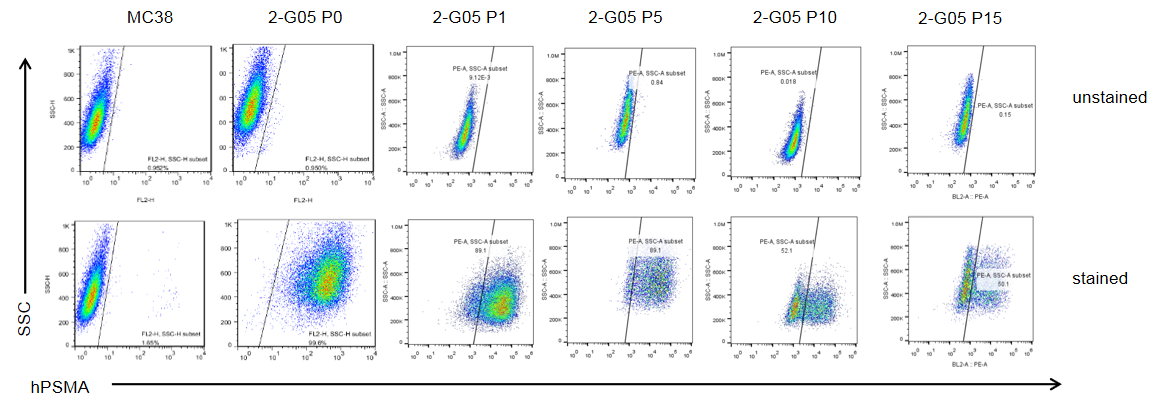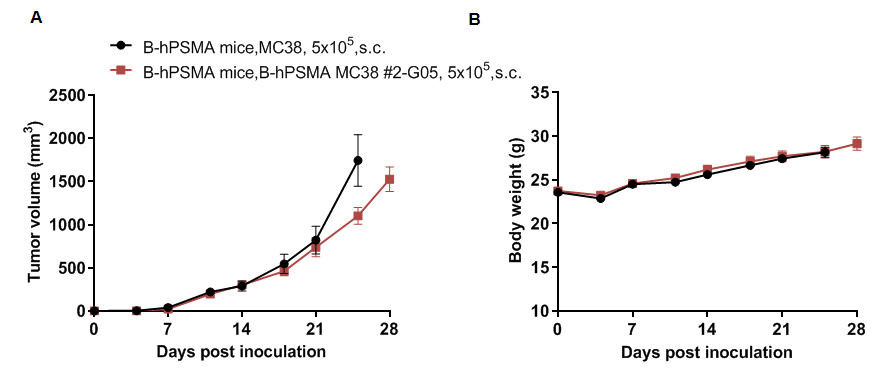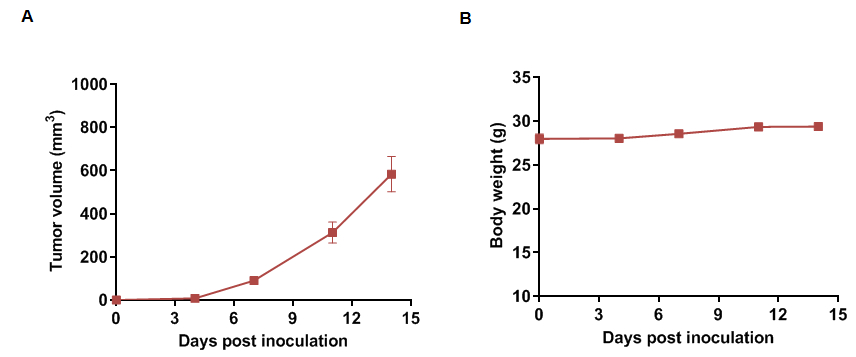Common name
|
B-hPSMA MC38
|
Catalog number
|
310840
|
|
Aliases
|
/
|
Disease
|
Colon carcinoma
|
Organism
|
Mouse
|
Strain
|
C57BL/6
|
|
Tissue types
|
Colon
|
Tissue
|
Colon
|
Description
The human PSMA coding sequence was inserted to mouse PSMA gene locus site. Human PSMA is highly expressed on the surface of B-hPSMA MC38 cells.
Application
B-hPSMA MC38 cells have the capability to establish tumors in vivo and can be used for efficacy studies.
Targeting strategy
Gene targeting strategy for B-hPSMA MC38 cells. The exogenous promoter and human
PSMA coding sequence was inserted to mouse
PSMA gene locus site. The insertion disrupts the endogenous murine
Psma gene, resulting in a non-functional transcript.
Protein expression analysis

PSMA expression analysis in B-hPSMA MC38 cells by flow cytometry. Single cell suspensions from B-hPSMA MC38 cultures were stained with species-specific anti-PSMA antibody. Human PSMA was detected on the surface of B-hPSMA MC38 but as the generation increases, the expression decreases.
User notes:
You can establish a working cell bank for low-passage cells to ensure the cells used in your experiment could express PSMA. The PSMA will lose express in high-passage cells.
Tumor growth curve & Body weight changes

Subcutaneous homograft tumor growth of B-hPSMA MC38 cells. B-hPSMA MC38 cells (5x105) and MC38 cells (5x105) were subcutaneously implanted into C57BL/6 mice (female, 7-week-old, n=5). Tumor volume and body weight were measured twice a week. Volume was expressed in mm3 using the formula: V=0.5 × long diameter × short diameter2. (A) Average tumor volume ± SEM. (B) Body weight (Mean± SEM). (C) Tumor cells were harvested and assessed for human PSMA expression by flow cytometry. As shown in panel, B-hPSMA MC38 cells were able to establish tumors in vivo but human PSMA was not expressed on the surface of tumor cells.

Subcutaneous homograft tumor growth of B-hPSMA MC38 cells. B-hPSMA MC38 cells (5x105) and MC38 cells (5x105) were subcutaneously implanted into C57BL/6 mice (female, 6-week-old, n=6). Tumor volume and body weight were measured twice a week. Volume was expressed in mm3 using the formula: V=0.5 × long diameter × short diameter2. (A) Average tumor volume ± SEM. (B) Body weight (Mean± SEM). (C) Tumor cells were harvested and assessed for human PSMA expression by flow cytometry. As shown in panel, human PSMA was not expressed on the surface of tumor cells 2-G05 and express decreases on tumor cells 7-B10.

Subcutaneous homograft tumor growth of B-hPSMA MC38 cells. B-hPSMA MC38 cells (5x105) and MC38 cells (5x105) were subcutaneously implanted into B-NDG mice (female, 8-week-old, n=5). Tumor volume and body weight were measured twice a week. Volume was expressed in mm3 using the formula: V=0.5 × long diameter × short diameter2. (A) Average tumor volume ± SEM. (B) Body weight (Mean± SEM). (C) Tumor cells were harvested and assessed for human PSMA expression by flow cytometry. As shown in panel, B-hPSMA MC38 cells were able to establish tumors in vivo and human PSMA was expressed on the surface of tumor cells.
Tumor growth curve & Body weight changes

Subcutaneous homograft tumor growth of B-hPSMA MC38 cells. B-hPSMA MC38 cells (5x105) and wild-type MC38 cells (5x105) were subcutaneously implanted into B-hPSMA mice (male, 8-week-old, n=4 or 5). Tumor volume and body weight were measured twice a week. (A) Average tumor volume ± SEM. (B) Body weight (Mean± SEM). Volume was expressed in mm3 using the formula: V=0.5 × long diameter × short diameter2. As shown in panel A, B-hPSMA MC38 cells were able to establish tumors in vivo and can be used for efficacy studies.

Subcutaneous homograft tumor growth of B-hPSMA MC38 cells. B-hPSMA MC38 cells (5x105) were subcutaneously implanted into heterozygous B-hCD3E/hPSMA mice (male, 9-week-old, n=5). Tumor volume and body weight were measured twice a week. (A) Average tumor volume ± SEM. (B) Body weight (Mean± SEM). Volume was expressed in mm3 using the formula: V=0.5 × long diameter × short diameter2. As shown in panel A, B-hPSMA MC38 cells were able to establish tumors in vivo and can be used for efficacy studies.
Protein expression analysis of tumor cells

B-hPSMA MC38 cells were subcutaneously transplanted into B-hCD3E/hPSMA mice, and on 14 days post inoculation, tumor cells were harvested and assessed for human PSMA expression by flow cytometry. As shown, human PSMA was highly expressed on the surface of tumor cells. Therefore, B-hPSMA MC38 cells can be used for in vivo efficacy studies of novel PSMA therapeutics.


















